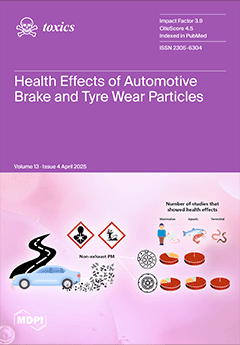Polycyclic aromatic hydrocarbons (PAHs) and global warming impact aquatic ecosystems, eventually interacting. Monolayer (2D) cultures of cell lines, such as the rainbow trout liver RTL-W1, are employed for unveiling toxicological effects in fish. Nonetheless, three-dimensional (3D) models constitute an alternate paradigm, better emulating
[...] Read more.
Polycyclic aromatic hydrocarbons (PAHs) and global warming impact aquatic ecosystems, eventually interacting. Monolayer (2D) cultures of cell lines, such as the rainbow trout liver RTL-W1, are employed for unveiling toxicological effects in fish. Nonetheless, three-dimensional (3D) models constitute an alternate paradigm, better emulating in vivo responses. Here, ultra-low attachment (ULA) plates were used to generate ten-day-old RTL-W1 spheroids for exposure to a control, a solvent control (0.1% DMSO) and the model PAH benzo[k]fluoranthene (BkF) at 10 and 100 nM and at 18 and 23 °C (thermal stress). After a 4-day exposure, spheroids were analyzed for viability (alamarBlue and lactate dehydrogenase), biometry (area, diameter and sphericity), histocytology (optical and electron microscopy), and mRNA levels of the detoxification-related genes cytochrome P450 (
CYP)
1A,
CYP3A27, aryl hydrocarbon receptor (
AhR), glutathione S-transferase (
GST), uridine diphosphate–glucuronosyltransferase (
UGT), catalase (
CAT), multidrug resistance-associated protein 2 (
MRP2) and bile salt export protein (
BSEP). Immunocytochemistry (ICC) was used to assess CYP1A protein expression. Neither temperature nor BkF exposure altered the spheroids’ viability or biometry. BkF modified the cell’s ultrastructure. The expression of
CYP1A was augmented with both BkF concentrations, while
AhR’s increased at the higher concentration. The CYP1A protein showed a dose-dependent increase. Temperature and BkF concurrently modelled
UGT’s expression, which increased in the 100 nM condition at 23 °C. Conversely,
CYP3A27,
MRP2, and
BSEP expressions lowered at 23 °C.
CAT and
GST mRNA levels were uninfluenced by either stressor. Overall, BkF and temperature impacted independently or interactively in RTL-W1 spheroids. These seem to be useful novel tools for studying the liver-related effects of temperature and PAHs.
Full article






